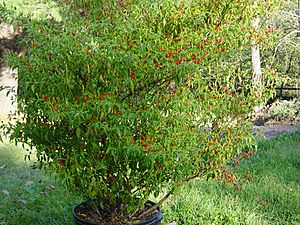Pequin pepper facts for kids
Quick facts for kids Pequin pepper |
|
|---|---|

Closeup of fruits, foliage, and flower
|
|
| Species | Capsicum annuum |
| Cultivar | Pequin |
| Heat | |
| Scoville scale | 30,000–60,000 SHU |
The Pequin pepper (also called piquín) is a tiny but very hot chili pepper. People often use it to add spice to their food. These peppers are super spicy, usually 5 to 8 times hotter than a jalapeño! On the Scoville scale, which measures how hot peppers are, Pequin peppers score between 30,000 and 60,000 units. Their flavor is often described as tasting a bit like citrus and nuts.
Pequin peppers originally come from the Mexican state of Tabasco. They are very popular there for making salsas and adding flavor to many dishes. This pepper has many different names depending on where you are. For example, it's called chiltepe in Guatemala and El Salvador, and chile congo in Nicaragua.
Contents
What Does a Pequin Pepper Look Like?
Pequin pepper plants are usually small, growing about 0.3 to 0.6 meters (1 to 2 feet) tall. They have bright green, oval-shaped leaves. The peppers themselves are tiny, rarely growing longer than 2 centimeters (less than an inch).
Like most chili peppers, the Pequin peppers start out green. As they ripen, they turn a bright, shiny red color. The name "Pequin" probably comes from the Spanish word pequeño, which means "small."
Where Do Pequin Peppers Grow?
You can find Pequin peppers growing wild from the American Southwest all the way down to the Andes mountains. They are also grown on farms in Mexico.
These peppers are very special in Mexico. They can sometimes cost more than 10 times the price of other peppers! This is because they are a bit tricky to grow. Not many of their seeds sprout (only about 15% on average), and the plants can easily get sick.
How to Grow Pequin Peppers
Pequin peppers like a bit of shade, about 35% shade is perfect for them. They also need to be watered every day, though they can handle dry spells too. In the wild, Pequin plants grow under trees and can live for many years. When people grow them on farms, they usually treat them like plants that only live for one year.
It takes a while for Pequin peppers to grow. Their seeds take 7 to 28 days to sprout. Then, it takes another 60 to 90 days for the seedlings to grow big enough to be planted. After they are planted, it takes about 90 to 100 more days for the plants to produce peppers that can be sold.
Climate and Environment
Pequin peppers can grow in many different places, from sea level up to 1300 meters (about 4,265 feet) high. You can find them in forests, along roads, in gardens, and even in fields.
For these peppers to grow well, the temperature needs to be between 18-30°C (64-86°F) during the day. At night, the temperature should be between 15-21°C (59-70°F). The lowest temperature they can handle for sprouting and growing is 15°C (59°F). They prefer shady or partly shady spots with not too much bright sunlight and shallow soil. If a plant gets damaged by frost, you can sometimes cut off the top part, and it might grow back if its roots are still healthy.
How Are Pequin Peppers Used?
Pequin peppers are used in many ways. People often use them for:
Some popular hot sauces, like Cholula, even use Pequin peppers as one of their main ingredients!
See also
 In Spanish: Chile piquín para niños
In Spanish: Chile piquín para niños


